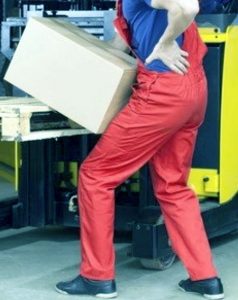What Is The Maximum Weight Limit I Can Lift At Work And Can I Claim Compensation?
By Stephen Hudson. Last Updated 19th September 2024. Following a manual handling injury at work, you may be wondering, “what is the maximum weight limit I can lift at work?”. However, there is no legal maximum weight limit. Instead, there are guidelines and recommendations regarding the maximum weight to lift at work.
In this guide, we’re going to review the recommended safe lifting limits and explain when you might be able to seek compensation for injuries related to lifting too many items or lifting something that was too heavy. We’ll look at your employer’s duty of care towards your safety, what considerations should be made when lifting, and how much compensation could be paid if your injury is caused by employer negligence.
Our advisors at Legal Expert can provide a no-obligation assessment of any workplace accident claim. If they believe that your personal injury claim has a chance of success, they could introduce you to one of our experienced No Win No Fee solicitors.
If you’d like to discuss making a manual handling claim right away, please call 0800 073 8804 today or use our live chat feature. You could also fill out our claim online form for a call back at a time that suits you. Otherwise, to find out more about claiming for lifting-related injuries, please continue reading.
Select A Section
- When Can I Claim For A Lifting Injury At Work?
- What Is The Maximum Weight Limit I Can Lift At Work?
- Weight Limit – Workplace Regulations And Split Liability
- Examples of Manual Handling Accidents
- I Was Injured When Lifting And Handling A Heavy Object, What Should I Do?
- How Much Can I Claim For A Lifting Injury At Work?
- Make A No Win No Fee Claim For A Manual Handling Injury
- Essential References On What Is The Maximum Weight Limit You Can Lift At Work
When Can I Claim For A Lifting Injury At Work?
Before we answer the question, “What is the legal limit for the maximum weight that can be lifted in the workplace?” let’s outline what you need to prove if you intend to make a manual handling compensation claim.
All employers owe their employees a duty of care, which is outlined by the Health and Safety at Work etc. Act 1974. This means that they have a legal responsibility for their employees’ health and safety.
If your employer breaches their duty of care, and this causes you to sustain an injury, this is known as negligence. You need to be able to prove that negligence occurred, otherwise it’s unlikely that you’ll be able to make a claim.
For example, your employer might be expected to undertake a risk assessment to help calculate what is the maximum weight a person should lift on their own. If they fail to do this, and you suffer a manual handling injury, you could potentially make a claim.
If you’d like to learn more, read on. Or, contact our team of advisors to find out if you could be entitled to make a claim.
What Is The Maximum Weight Limit I Can Lift At Work?
You may be asking, “What is the legal limit for the maximum weight that can be lifted in the workplace?” Manual handling tasks at work can pose certain risks. Therefore, employers must adhere to certain pieces of legislation to manage the risks.
The Manual Handling Operations Regulations 1992 sets out that employers should:
- Avoid any manual handling tasks so far as reasonably possible.
- Where it is not possible, assess the risk of injury posed by any hazardous manual handling activities that can’t be avoided.
- Take steps to reduce the risk of injury as much as reasonably possible.
While the weight of a load is important, the law does not set any specific weight limit for manual handling tasks.
The Health and Safety Executive (HSE), the regulator for workplace health and safety in Great Britain, provides some guidance on weight limits depending on your height, gender, and the height from where you lift.
For example, the HSE’s guidance states that at elbow height, the maximum a man should lift is 20kg while, for a woman, it is 13kg. However, this can depend on your height and other factors. Therefore, your employer will need to assess the maximum weight that is suitable for you to lift before you carry out manual handling tasks.
If you’ve suffered injuries from a manual handling task at work, you can contact our advisors for free today for advice on whether you’re eligible to claim against your employer.
Weight Limit – Workplace Regulations And Split Liability
When lifting a load, you need to adhere to the official training and guidance you should have been supplied with. Failure to do so could affect your claim. You have some responsibility for your own safety whilst at work. It is not solely down to your employer.
As well as asking “what’s the weight limit when lifting at work?”, you also need to consider other factors that could affect your safety when engaging in manual handling. When heavy lifting at work, the law states that your employer must take reasonably practicable steps to reduce your risk of injury. However, if you take unnecessary risks, then the liability could fall – at least partially – with you. This is known as split liability.
If split liability is established, then you will receive a reduced payout. For instance, if it is deemed you were 50% responsible for how you were injured, you would only receive 50% of the payout you would have received if the liability rested entirely with your employer.
When lifting a load, you need to take into account factors in addition to the weight limit, such as:
- Any pre-existing injuries you may have
- If there are any hazards present
- Carelessness
- Whether you are adhering to the training you’ve been provided with
If you have any questions, please get in touch with our advisors today.
Examples Of Manual Handling Accidents
Manual handling accidents could occur in a variety of ways. In this section, we’ve given a short list of examples below. However, there are other scenarios in which heavy lifting at work could cause you to be injured due to negligence.
- Inadequate training – You may have been asked to lift a heavy load, but not told how to do so in a safe manner. There are certain tips and techniques for manual handling that can reduce the risk of injury. If you are not made aware of them, then you could be hurt.
- Unsafe walking surfaces – Even if you are carrying something safely, the floor may be slippery or damaged. This could cause you to fall and become injured.
- Exceeding the maximum safe weight – If you carry weight heavier than is deemed safe, then this could also lead to you sustaining an injury. The damage could occur due to an isolated incident, or it could be cumulative. Also bear in mind that you can refuse to lift something if you feel you are incapable of safely doing so.
Reach out today if you have any questions regarding whether the scenario that caused your injury could be an example of negligence.
I Was Injured When Lifting And Handling A Heavy Object, What Should I Do?
If you have been injured in a manual handling accident at work, you’ll need to supply evidence to support your claim. The more evidence you can supply, the easier it will be to show what happened. Therefore, in the event of an accident, we’d suggest that you:
- Report the accident to your employer. By law, the incident will need to be recorded, and you can ask for a copy of the accident report to help prove what happened and when.
- Photograph the scene of the accident. For manual lifting injuries, it would be worth trying to capture the size of the area you were working in and the load you were lifting. Try to do this as soon as possible before anything is removed from the scene.
- Seek medical treatment for your injuries. Not only will this help you recover, but medical records could also be used to show the extent of your injuries.
- Ask any witnesses for their details.
- Ask for copies of any CCTV footage that was covering the area. You should do this as soon as possible as it’s not always retained for long periods.
- If you have any visible injuries, photograph them throughout your recovery.
Once you’ve got as much evidence as you’re able to, please call and speak with an advisor. They’ll go through your claim with you and advise you of your options. If the claim is strong enough, they could introduce you to a specialist solicitor to take your manual handling claim forward.
How Much Can I Claim For A Lifting Injury At Work?
If you successfully claim compensation for an injury from lifting at work, there are two heads of claim you could receive: general damages and special damages. General damages is awarded in every successful claim and provides compensation for your injuries and the effect they have on your daily life.
When solicitors and other legal professionals value this head of claim, they may refer to the Judicial College Guidelines (JCG). This is a document that provides guideline compensation amounts for injuries of varying severities. In the table below, you can find some examples of these guidelines relevant to injuries you could sustain due to heavy lifting at work. These figures have been taken from the 16th edition of the JCG.
| Injury | Guideline Amount |
|---|---|
| Multiple Serious Injuries and Financial Losses | Up to £1,000,000+ |
| Paralysis - Paraplegia | £267,340 to £346,890 |
| Back Injuries - Severe (i) | £111,150 to £196,450 |
| Back Injuries - Severe (iii) | £47,320 to £85,100 |
| Back Injuries - Moderate (ii) | £15,260 to £33,880 |
| Back Injuries - Minor (i) | £9,630 to £15,260 |
| Injuries to the Elbow - Severely Disabling Injury | £47,810 to £66,920 |
| Shoulder Injuries - Severe | £23,430 to £58,610 |
| Shoulder Injuries - Serious | £15,580 to £23,430 |
| Knee Injuries - Moderate (i) | £18,110 to £31,960 |
| Knee Injuries - Moderate (ii) | Up to £16,770 |
Can I Claim Special Damages?
Your compensation may also include special damages. This head of claim covers the financial losses you suffer because of your injuries. For example, this head could help you recover the cost of:
- Housekeeping
- Lost earnings
- Childcare
- Travel
- Prescriptions
- Mobility aids
However, in order to claim under this head, you must be able to provide proof of your losses. Because of this, it can be helpful to keep any relevant bills, invoices, or receipts that relate to expenses caused by your injuries.
Read on to learn more about claiming for injuries caused by your employer asking you to lift over the maximum lifting weight. Or, contact our team to get started.
Make A No Win No Fee Claim For A Manual Handling Injury
When making a personal injury claim for injuries caused by exceeding the manual handling weight limit in the UK, you may find it helpful to work with a No Win No Fee solicitor. They could offer you a specific type of contract called a Conditional Fee Agreement. When claiming with this type of No Win No Fee deal in place, you pay your solicitor a legally capped success fee when you make a successful claim and are awarded compensation. If your claim fails, you are not required to pay them this.
Our solicitors could work your case under this type of No Win No Fee arrangement. To find out more about whether you could claim following an injury after the maximum weight for manual handling was exceeded in the workplace, get in touch with our advisors today. An advisor can discuss whether a solicitor could begin working on your case. To get in touch, you can:
- Call us on 0800 073 8804
- Talk to us about your claim online
- Use the pop-up chat window
Essential References On What Is The Maximum Weight Limit You Can Lift At Work
Thanks for reading this guide that aimed to answer the question, “what is the maximum weight limit I can lift at work?” To provide you with further information, we’ve linked to a few more of our guides as well as some useful external resources too. Please feel free to get in touch if there’s anything else you’d like to know.
- No Win No Fee claims – This guide looks at the process of claiming on a No Win No Fee basis.
- Manual Handling At Work – A brief guide on lifting, and the laws around workplace practices, from the Health and Safety Executive.
- The Lifting Operations and Lifting Equipment Regulations 1998 – Legislation that puts a duty on companies who operate or own lifting equipment.
- Sprains And Strains – A guide from the NHS which helps you to check if you’ve strained or sprained a muscle.
Below, you can find a list of guides which may tell you more about accident at work claims:
- Discover more answers to your queries on our accident at work FAQs page
- Can I claim compensation if I’ve left the company?
- Can you lose your job if you claim against your employer?
- Injured due to tiredness or fatigue – can I claim?
- I hurt myself at work, can I make a claim?
- What to do if you cut off your finger at work
- I suffered a burn injury at work, how much could I claim in compensation?
- How to claim compensation for industrial dermatitis
- I was injured at work – what are my rights?
- Is my employer liable for an accident at work?
- What should I do if I hurt myself at work?
- Who pays my medical bills if I’m injured at work?
- Can I make a claim if injured in my probation period?
- Who pays damages in an accident at work claim?
- I slipped on water at work, can I make a claim?
- Does my employer pay my medical bills if I’m injured at work?
- Can you still claim compensation f you didn’t take time off work?
- Do you have to be an employee to make a workplace injury claim?
- I am a new employee, can I make a claim?
- How do you prove an accident at work claim?
- Do you need to be an employee to make a workplace accident claim?
- What happens if you do not report an injury or accident?
- Can I make a claim if I’m an agency worker?
- I was dismissed after an accident at work, what should I do?
- If I was partly at fault for an accident can I still make a claim?
- I am self-employed and had an accident at work, can I make a claim?
- I had an accident at work due to no safety boots – can I make a claim?
- Can an apprentice make an accident at work claim?
- I suffered a head injury due to no helmet – can I make a claim?
- Can I claim if injured because of no safety goggles?
- What is the time limit for an accident at work claim?
- What are my employers’ responsibilities after an accident at work?
- Will suing my employer create problems?
- How to make a claim for inadequate tools and equipment
- I had an accident at work, what are my rights?
- Who has the overall responsibility for recording injuries at work?
- How long after an injury at work can I make a claim?
- I fell down the stair at work, can I make a claim?
- Learn more about accident at work claims here
If you would like to speak to an advisor who can answer questions such as “what is the maximum weight limit I can lift at work?” or similar, you can get in touch with Legal Expert using the contact details highlighted in this guide.







